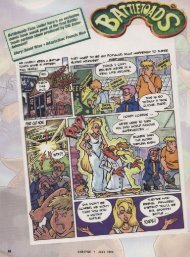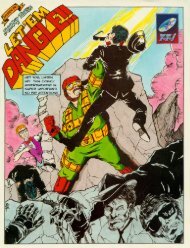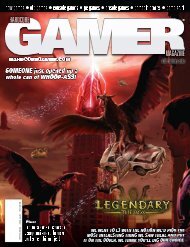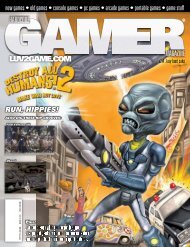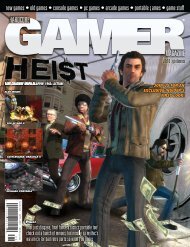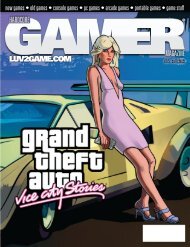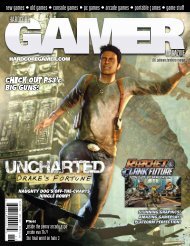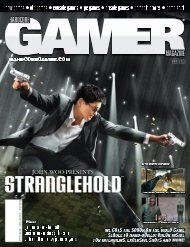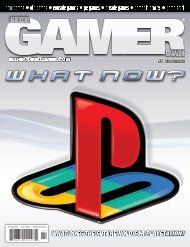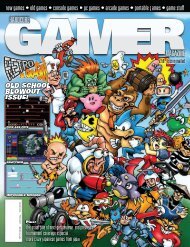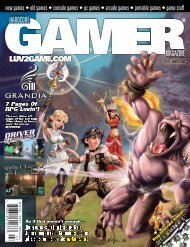worth importing? - Defunct Games
worth importing? - Defunct Games
worth importing? - Defunct Games
Create successful ePaper yourself
Turn your PDF publications into a flip-book with our unique Google optimized e-Paper software.
1977<br />
2005<br />
With the next generation of console hardware right around the corner, a lot of the hype we’ve been<br />
hearing about upcoming games has focused heavily on the visuals. From Sony’s scripted Killzone<br />
demo to the stunning graphics of Epic’s Gears of War, both Microsoft and Sony have been<br />
chanting the mantra of visual supremacy.<br />
As any hardcore gamer knows, though, graphics in and of themselves don’t make<br />
a game fun. You can render something with millions of polygons, polish it off<br />
with high-resolution textures, and spice it up with plenty of lighting tricks,<br />
but if the shiny object on screen isn’t any fun to move around, then all is for<br />
naught. After all, when it comes right down to it, every video game is little more<br />
than pushing pixels around on the screen.<br />
Today, it takes a large team of programmers with budgets of millions of dollars to make those<br />
pixels move, but back in the early days of the industry it wasn’t unusual for a “team” to consist of two<br />
or three programmers, with some games requiring only one. Welcome to the dawn of the video game era.<br />
The Atari may not have been the first console on the market<br />
(both the Magnavox Odyssey and the Fairchild beat it home),<br />
but it was undoubtedly the most successful, with young Baby<br />
Boomers wasting countless hours in front of the Atari 2600.<br />
Yes, the games were simple and they often looked nothing like<br />
their arcade counterparts, but they were fun and in the end<br />
that was all that mattered.<br />
Facing competition from the technically superior Mattel Intellivision<br />
system, Atari eventually released upgraded consoles (even<br />
pioneering backwards compatibility years before Sony claimed to<br />
be the “first” to do it), but none of the later iterations were able<br />
to penetrate popular culture to the same degree as the original.<br />
More than twenty-five years after the “heavy sixer” (so named<br />
due to its noticeable weight and six configuration buttons)<br />
debuted, the Atari 2600 is far from a dead system. A quick scan<br />
of eBay turns up hundreds of auctions for the common titles,<br />
and the rarer gems trade for tidy sums in the collector’s market.<br />
Prototype games are still being discovered -- sometimes after<br />
being buried in the back of someone’s closet for years -- while<br />
homebrew programmers have mastered the system and are busy<br />
creating new software for it. Yes, you heard right; new software<br />
is still being released for the Atari 2600.<br />
If you’re into classic gaming, tracking down a system is fairly<br />
trivial, but for the rest of us it can be something of a chore.<br />
How do you know that system you just picked up at a garage<br />
sale actually works? Where do you buy a replacement joystick?<br />
Most importantly, how do you connect that old RF switch to your<br />
brand spanking new HDTV?<br />
Atari took a stab at solving these problems with last year’s<br />
release of the Atari Flashback system. Modeled after the Atari<br />
7800, it was an impressive effort, selling over half a million units,<br />
but suffered from a few key flaws such as uncomfortable joystick<br />
controllers and inaccurate emulation. The core of last year’s Atari<br />
Flashback wasn’t actually an Atari. Instead, it was an “NES-ona-chip,”<br />
and the games were recreations rather than the original<br />
code. As a result they played decently enough, but didn’t quite<br />
capture the magic of the real thing. For the Atari Flashback 2.0,<br />
however, Atari decided that “good enough” wasn’t acceptable.<br />
The Atari Flashback 2.0 is a brand new machine, designed from<br />
the ground up. It consists of a complete “2600-on-a-chip,” a<br />
40-games-in-one ROM and a little circuitry to hold it all together.<br />
Amazingly light, the case draws its inspiration from two separate<br />
2600 models, the 1978 and 1980 releases. The small switches on<br />
the front have been replaced with easy-to-press buttons, but the<br />
grooved surface and the faux woodgrain are completely intact.<br />
by Syriel<br />
Even the box evokes a bit of nostalgia, as it is plastered with<br />
goofy looking pictures of people having “fun.”<br />
The original Atari 2600 controllers have been recreated and<br />
connect to the back of the unit via standard plugs. Though the<br />
joysticks still feature the angular contours of yore, the internals<br />
have been updated allowing for a slightly more comfortable<br />
experience. Because they are detachable, you can use the new<br />
controllers on an original Atari 2600 as well as use any existing<br />
peripherals with the Atari Flashback 2.0. Nice.<br />
Topping the list of hardware innovations, though, is the standard<br />
A/V cable on the back of the system. Unlike the Atari 2600, which<br />
only offered an RF connection, the Atari Flashback 2.0 plugs right<br />
into your TV via the composite video connector. The resulting picture<br />
quality is surprisingly good, especially for those of you who<br />
remember playing though a snowy picture thanks to interference<br />
on channel 3 or 4. Our only complaint with the setup is the fact<br />
that the A/V cable is permanently connected to the console.<br />
After we connected everything, it was time to power up the system.<br />
Unlike current generation consoles, which have to advertise<br />
their presence with a lengthy boot sequence, the Atari Flashback<br />
2.0 immediately presents you with a custom boot menu offering<br />
four choices: Adventure Territory, Arcade Favorites, Space Station<br />
and Skill and Action Zone. Choose a category to bring up a list of<br />
available games and select the one you wish to play. To start a<br />
new game, simply power cycle the system.<br />
What makes the game selection on the Atari Flashback 2.0 stand<br />
out is its variety. Big name titles such as Pitfall!, River Raid and<br />
Adventure all make an appearance, alongside arcade classics<br />
The Ultimate<br />
Hardware Hacker<br />
So, you think you’re good at hardware hacking? Done a<br />
little case modding in your time? Chances are good that<br />
Ben Heckendorn has you beat when it comes to hacking<br />
console systems. The creator of the original portable Atari<br />
2600, Heckendorn has made a hobby out of converting<br />
video game consoles into portable variants. If you<br />
have the time, check out his site at www.benheck.com.<br />
Amongst his many creations is a PlayStation Portable<br />
fashioned out of a PSone, and dubbed the PSP long before<br />
Sony decided to enter the handheld market.<br />
HARDCORE GAMER MAGAZINE_VOLUME 1_ISSUE 4_A pr0nLESS PUBLICATION<br />
<strong>Games</strong>,<br />
<strong>Games</strong>,<br />
<strong>Games</strong>!<br />
YOU’LL FIND THE FOLLOWING<br />
TITLES PACKED INTO EVERY<br />
ATARI FLASHBACK 2.0 SYSTEM.<br />
Adventure Territory includes:<br />
Adventure (1 player)<br />
Adventure II (1 player)<br />
Haunted House (1 player)<br />
Return To Haunted House (1 player)<br />
SecretQuest (1 player)<br />
Wizard (1 or 2 players)<br />
Arcade Favorites includes:<br />
Arcade Asteroids (1 or 2 players)<br />
Arcade Pong (1 or 2 players)<br />
Asteroids Deluxe (1 or 2 players)<br />
Battlezone (1 player)<br />
Centipede (1 or 2 players)<br />
Lunar Lander (1 player)<br />
Millipede (1 player)<br />
Missile Command (1 or 2 players)<br />
Space Duel (1 or 2 players)<br />
Space Station includes:<br />
Caverns of Mars (1 or 2 players)<br />
Quadrun (1 player)<br />
Saboteur (1 player)<br />
Space War (1 or 2 players)<br />
Yars’ Revenge (1 or 2 players)<br />
Yars’ Return (1 or 2 players)<br />
Skill and Action Zone includes:<br />
3D Tic-Tac-Toe (1 or 2 players)<br />
Aquaventure (1 player)<br />
Atari Climber (1 player)<br />
Combat (2 players)<br />
Combat 2 (2 players)<br />
Dodge’em (1 or 2 players)<br />
Fatal Run (1 or 2 players)<br />
Frog Pond (2 players)<br />
Hangman (1 or 2 players)<br />
Human Cannonball (1 or 2 players)<br />
Maze Craze (1 or 2 players)<br />
Off The Wall (1 or 2 players)<br />
Outlaw (1 or 2 players)<br />
Pitfall! (1 player)<br />
Radar Lock (1 or 2 players)<br />
River Raid (1 or 2 players)<br />
Save Mary (1 player)<br />
Video Checkers (1 player)<br />
Video Chess (1 player)<br />
like Asteroids and competitive two<br />
player games like Combat. Keen<br />
eyes will also notice a number of<br />
previously unreleased prototype<br />
and brand new homebrew games,<br />
giving even the most avid Atari fan<br />
something new to play.<br />
Despite their relative simplicity,<br />
most gamers will find that the<br />
included games are quite enjoyable.<br />
As one of the earliest shoot-em-ups<br />
to hit the home console, River Raid<br />
may not be able to compete with<br />
the likes of Ikaruga, but it features<br />
a surprising amount of depth. Players<br />
will have to control their speed<br />
as well as keep an eye on their fuel<br />
level, as they maneuver through<br />
enemy territory, shooting down<br />
ships, planes and bridges all while<br />
avoiding incoming fire.<br />
Save Mary has you mastering the art<br />
of block stacking in order to rescue<br />
your beloved girlfriend from the fast<br />
rising waters of a broken dam, while<br />
Video Checkers will challenge your<br />
strategic ability. The Atari can be a<br />
surprisingly astute opponent, as we<br />
quickly found out.<br />
As a solid collection of Atari 2600<br />
games, the Atari Flashback 2.0 is<br />
well <strong>worth</strong> the cost. For the budding<br />
hardware hacker and hardcore fan,<br />
the Atari Flashback 2.0 gets even<br />
better. Since the new system uses<br />
miniaturized versions of the original<br />
hardware, it’s technically capable<br />
of running any original Atari 2600<br />
software. The only thing standing in<br />
your way is the lack of a cartridge<br />
port, but as you’ll soon find out, this<br />
is only a minor obstacle.<br />
Atari certainly had the hardcore<br />
fans in mind when designing the<br />
Atari Flashback 2.0 as the internal<br />
connections are well documented;<br />
it’s relatively easy to connect a real<br />
cartridge port to the system. You’ll<br />
have to void your warranty and do<br />
a little soldering, but when you’re<br />
done you will be able to run nearly<br />
any game. The truly adventurous<br />
(we’re talking to you, Ben Heckendorn)<br />
will also love the small size of<br />
the system board, making it ideal for incorporation into a custom design.<br />
No matter if you’re looking to relive your youth or just satiate a little retro fever,<br />
it’is hard to go wrong with the Atari Flashback 2.0. Well-constructed and<br />
packed with an enviable collection of titles, it puts other plug-and-play games<br />
to shame. Now, if only someone would<br />
do an Intellivision Flashback console,<br />
we’d be in heaven. No matter how<br />
good it is, emulation cannot compare 5 of 5<br />
to the “real thing.”<br />
HARDCORE GAMER MAGAZINE_VOLUME 1_ISSUE 4_A pr0nLESS PUBLICATION<br />
Atari<br />
2600<br />
Homebrew<br />
Homebrew<br />
Homebrew<br />
Spotlight<br />
Spotlight<br />
by<br />
Melf<br />
Gamers in the know are well aware that the discontinuation<br />
of a console doesn’t necessarily mean<br />
that it must be confined to the dank, dark depths<br />
of basements and closets. The rise in interest in<br />
retro gaming has led to a surge in the number of<br />
homebrew games being released. Long after they<br />
were put out to pasture, many consoles like the<br />
Atari 2600, Atari 5200, Colecovision, Intellivision,<br />
and even the Dreamcast have come back to enjoy<br />
new titles that were either left incomplete when<br />
the manufacturer moved on, or even entirely new<br />
games from up-and-coming developers who wish to<br />
share their love—and talent—with others.<br />
The inclusion of several homebrew and unreleased<br />
prototype games within the Flashback 2.0, while<br />
very cool, is mearly the tip of the iceburg. There’s<br />
just so much more neat stuff out there that we<br />
couldn’t resist showing off a few of the ones that<br />
really grabbed our attention. Compared to other<br />
consoles, the Atari 2600 has been receiving the lion’s<br />
share of homebrew games over the last couple of<br />
years, with a slew of titles appearing at trade shows<br />
and on retro store sites. Many even sport authentic<br />
cartridges (with label), boxes, and manual, making<br />
them instant collector’s items. Literally dozens of<br />
titles have been released since Ed Federmeyer first<br />
introduced us to his SoundX utility cartridge in 1994,<br />
and the homebrew scene shows no sign of slowing<br />
down. Now is a great time to get into the 2600, and<br />
the support offered by such sites as Atari Age (www.<br />
atariage.com) make the it one of the more interesting<br />
consoles to collect for. Some of these games are<br />
better than others, but a few manage to stand out<br />
among the crowd. Here are a few of the homebrew<br />
games that we feel are <strong>worth</strong> tracking down.<br />
BACKFIRE (By Chad Lare)<br />
My first impression of Backfire was that it resembled<br />
Atlantis in style. It is, however, much more complicated,<br />
and the spike in difficulty can sometimes<br />
catch you off guard. Backfire’s challenge level is<br />
so high that the standard difficulty switches have<br />
no effect! With your guns<br />
anchored at the top and<br />
bottom of the screen, you<br />
must maneuver either<br />
left or right to destroy the<br />
planes that are passing by.<br />
The closer to the middle<br />
they are, the more points you earn. As you take<br />
them out, the screen changes, and green deflectors<br />
obstruct much of your firing area. Hit them and<br />
your shots bounce right back at you. You must also<br />
take care not to shoot your own gun! UFOs offer<br />
points and extra lives, and failing to shoot them<br />
down will make the stage almost impossible.<br />
(continued on page 39)



